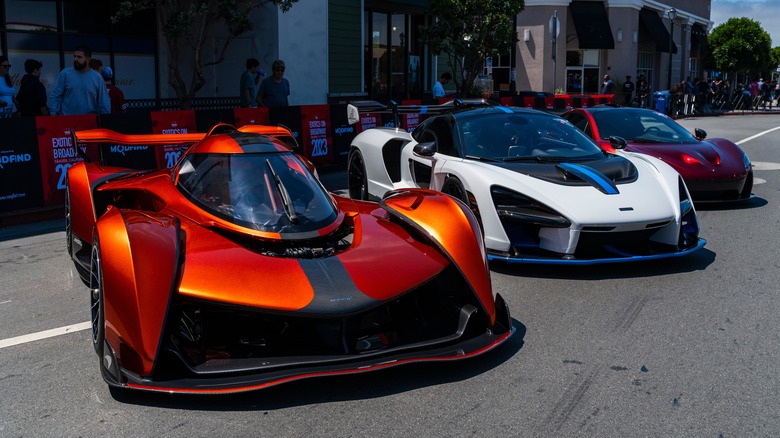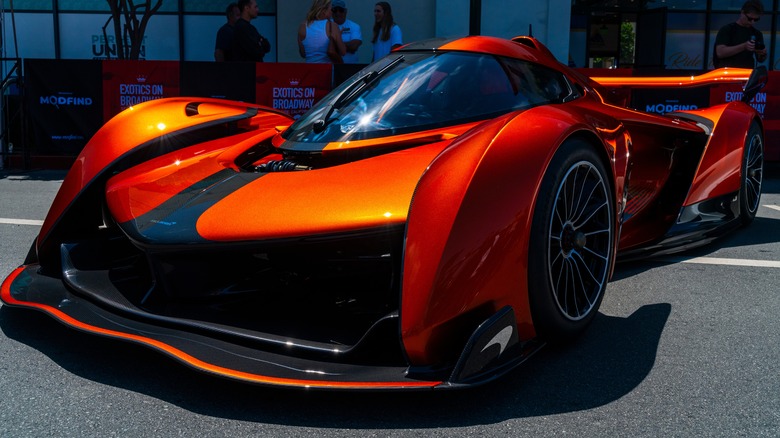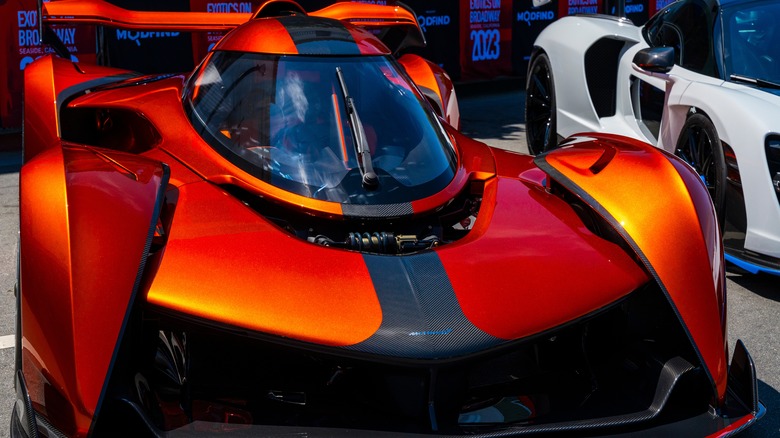Everything McLaren Fans Should Know About The Solus GT
The McLaren Motor Company has been building production cars since 2010. The latest to come out of the southern England workshop is the Solus GT, an F1-inspired single-seater designed to whip around the racetrack at top speed. With a pedigree reaching back to the 1960s, McLaren is no slouch when it comes to building fast cars, but racing proved too expensive a venture on its own. Like Ferrari and Ford, the company has funded its on-track activities by making sports cars for years, with one of its most notable early examples being the super-fast McLaren F1, the only road-legal car capable of breaking the 200 mph mark when it released in 1994.
With landmark entries like the 750S, P1, GTS, 12C, and Senna under its belt, McLaren has developed a reputation for building some of extremely well-regarded sports cars. The latest, however, takes a distinct approach to roasting the racetrack. The Solus GT is not just any racer. It's a pure track machine, and its technology and innovations make it one of the most interesting products to hit the (private) road this year. In short, it's a designer's dream designed to dominate. Lets take a closer look at this new video game-inspired dream car.
The Solus GT is not street-legal
Though not a professional racer, the Solus GT is purely built for the track. Road-going production cars have to meet federal safety and design regulations. Things like turn signals and lights, bumper height, crash ratings, and comfort are less of a priority for racers. This allows manufacturers to narrow their focus to what makes a car fast, which usually means losing anything that causes extra weight. Things like radios and speakers, sound insulation, and power accessories go out the window for the track.
With a design ethos rooted in open-wheel Formula racing, the Solus GT is hardly a tourer, despite remaining elegant and functional. Shallow ground clearance, lack of lights, and racing tires make taking the Solus for a grocery run ill-advised, and more importantly illegal. However, thanks to its track-only designation, the Solus GT does not have to meet emission regulations, meaning every design aspect can be devoted to performance.
It is a single-seater
Though McLaren does make road-going touring cars, the Solus GT is not exactly a 750S. Rare even among hypercars, it has a single seat in the cockpit's center. The fighter jet inspired canopy slides forward, and drivers must boost themselves on steps built into the monocoque body to clamber in.
Once inside, the driver becomes the center of weight in the car. The single-seat setup and bubble canopy give drivers a better sense of track position and a nearly unobstructed 360-degree view, maximizing the opportunity to push the Solus to its limits on the track.
The steering wheel is pure F1, with a flattened yoke adorned with buttons for making on-the-fly adjustments to brake and aero systems. Paddle shifters mounted on the rear of the wheel mean you won't be able to one-hand this car when driving. The only real adjustment available is a red loop that allows drivers to change the position of the pedals. But that shouldn't worry would-be buyers because McLaren provides a custom-built seat molded to the dimensions of the driver, who must undergo a personal seat-fitting session with the company.
It was inspired by a video game
Most cars begin life as a concept borne from the minds of engineers and designers, but not the Solus GT. Its earliest concept appeared in 2017's "Grand Turismo Sport" video game. The whole thing started when Gran Turismo producer Kazunori Yamauchi asked manufacturers if they would build a virtual concept car as the ultimate expression of a fantasy car. Unrestricted by real-world considerations, McLaren design director Rob Melville designed it himself.
The virtual car included much of the shape and look of what would eventually become the Solus GT. In Gran Turismo, it features a 4.0-liter V8 turbo powering the rear wheels and a pair of electric motors powering each of the front wheels, for a total of 1,134 hp. However, there is one significant difference: Drivers of the virtual car would lie on their bellies to pilot it.
Pleased with the reception, the McLaren management team gave its engineers and designers permission to produce the Vision GT car in real life. The Solus GT arrived as the physical manifestation of that virtual fever dream — not your typical design story!
It has 829 horsepower
With a manufacturing firm like McLaren behind it, you know the Solus GT won't lack power. Though the pie-in-the-sky dreams of the virtual Gran Turismo design aren't yet possible (keeping it under 2,200 pounds with dual electric motors just wasn't in the cards), it's still not too shabby in the power department.
The physical manifestation of the Solus GT ditched the original V8 for a naturally aspirated 5.2-liter V10 with a sky-high red line of 10,000 RPM. And that's not all; extensive aero testing created a machine that makes just over 2,645 pounds of downforce, or 20% more than the car's weight, as it careens around the track.
All this translates to 829 hp and 479 lb-ft of torque. The engine is entirely gear-driven, akin to Bougatti's recent fine watch-inspired Bugatti Tourbillon. A bespoke seven-speed gearbox serves as the transmission, and extensive titanium and carbon fiber construction contributes to a weight of a mere 1,000 kilograms.
It costs over 3 million dollars – if you can get your hands on it
As a McLaren supercar, not everyone has the account balance to buy the Solus GT. And aside from the price, the limited production run and the fact that it's a pure track car make it particularly difficult to add to the stable.
Dedicated McLaren maniacs with deep pockets should expect to spend over $3 million to add it to their collection. That's over a million dollars more expensive than similar cars like the Ford GT Mk IV or Aston Martin Valkyrie.
The Solus GT is a one-off production car of which only 25 exist or are planned to exist, and each one is already spoken for. If you're not one of the lucky ones, maybe keep an eye on the used market. Surely, they'll lose value as soon as they're released, just like a Ford Focus. Right?





